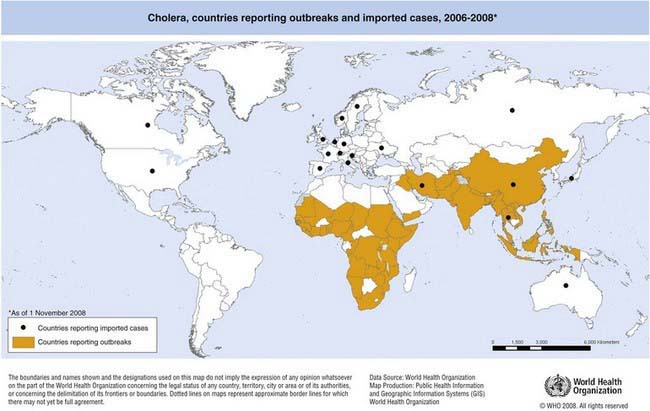Chapter 193 Cholera
Cholera is a rapidly dehydrating diarrheal disease that can lead to death, if appropriate treatment is not provided immediately. Although rare in industrialized countries, cholera has a propensity to cause outbreaks in areas with poor hygiene and inadequate sanitation and water facilities. These outbreaks may be explosive, especially when they occur in populations residing in crowded conditions, such as refugee camps. Reports from the World Health Organization (WHO) indicate that cholera is on the rise, with more cases being reported annually from 2006 and 2007 compared to the annual average of 2002-2005. In 2007, there were 177,963 cholera cases reported, with 4,031 deaths; actual figures may be higher.
Etiology
The disease is caused by Vibrio cholerae, a gram-negative comma-shaped bacillus, subdivided into serogroups by its somatic O antigen. Of the more than 200 serogroups, only serogroups O1 and O139 have been associated with epidemics, although some non-O1, non-O139 V. cholerae strains (e.g., O75 and O141) are pathogenic and can cause small outbreaks. A flagellar H antigen is present but is not used for species identification. The O1 serogroup is further divided into classical and the El Tor biotypes based on its biochemical characteristics. Since the turn of the century, only O1 El Tor has been reported; hybrids and variants of V. cholerae O1 El Tor possessing classical genes have been reported in Asia and Africa. Each biotype may be further subdivided into Inaba, Ogawa, and Hikojima serotypes based on the antigenic determinants on the O antigen. Inaba strains have A and C antigenic determinants, whereas Ogawa strains have A and B antigenic determinants. Hikojima strains produce all 3 antigenic determinants but are unstable and rare.
Epidemiology
The first 6 cholera pandemics originated in the Indian subcontinent and were caused by classical O1 V. cholerae. The seventh pandemic is the most extensive of all and is caused by V. cholerae O1 El Tor. It began in 1961 in Sulawesi, Indonesia, and has spread to the Indian subcontinent, Southeast Asia, Africa, Oceania, Southern Europe, and the Americas. In 1991, V. cholerae O1 El Tor first appeared in Peru before rapidly spreading in the Americas. Cholera becomes endemic in areas following outbreaks when a large segment of the population develops immunity to the disease after recurrent exposure. The disease is now endemic in parts of East, Southern, and Northwest Africa, as well as in South and Southeast Asia (Fig. 193-1).

Figure 193-1 Countries reporting cholera outbreaks and imported cholera cases to WHO from 2006-2008.
(From World Health Organization: Cholera, areas reporting outbreaks, 2007-2009 (website). gamapserver.who.int/mapLibrary/Files/Maps/Global_ChoeraCases_ITHRiskMap.png. Accessed August 9, 2010.)
The hybrid El Tor strains were first identified sporadically in Bangladesh. In 2004, during routine surveillance in Mozambique, isolates of V. cholerae O1 El Tor carrying classical genes were identified. Since then, hybrid and variant El Tor strains have been reported in other parts of Asia and Africa and have caused outbreaks in India and Vietnam. Although the classical biotype has virtually disappeared, its genes remain within the El Tor biotype.
Humans are the only known hosts, but free-living and plankton-associated V. cholerae exist in the marine environment. The organism thrives best in moderately salty water but can survive in rivers and freshwater if nutrient levels are high, as occurs when there is organic pollution such as human feces. The formation of a biofilm on abiotic surfaces and the ability to enter a viable but nonculturable state has been hypothesized as factors that allow V. cholerae to persist in the environment. Surface sea temperature, pH, chlorophyll content, the presence of iron compounds and chitin, and climatic conditions such as amount of rainfall and sea level rise are all important environmental factors that influence the survival of V. cholerae in the environment and the expression of cholera toxin, an important virulence determinant.
Consumption of contaminated water and ingestion of undercooked shellfish are the main modes of transmission, with the latter more often seen in developed countries. Previous studies in Bangladesh revealed that children aged 2-4 yr have the highest incidence of the disease; data from two endemic areas in Jakarta, Indonesia, and Kolkata, India, revealed that the incidence of disease was highest among infants and children <2 yr of age. On the other hand, all age groups were commonly affected in areas where the disease has not gained a foothold. In epidemic and endemic settings, the disease usually first appears in men. Persons with blood group O, decreased gastric acidity, malnutrition, immunocompromised state, and absence of local intestinal immunity (prior exposure by infection or vaccination) are at increased risk for developing severe disease. Household contacts of cholera-infected patients are at high risk for the disease, because the stools of infected patients contain high concentrations of V. cholerae (up to 108/gof stool).
Pathogenesis
Following ingestion of V. cholerae from the environment, several changes occur in the vibrios while they traverse the human intestine: increased expression of genes required for nutrient acquisition, downregulation of chemotactic response, and expression of motility. Together these changes allow the vibrios to reach a hyperinfectious state, leading to lower infectious doses in secondarily infected persons.
Large inocula of bacteria (>108) are required for severe cholera to occur; however, for persons whose gastric barrier is disrupted, a much lower dose (105
Stay updated, free articles. Join our Telegram channel

Full access? Get Clinical Tree


